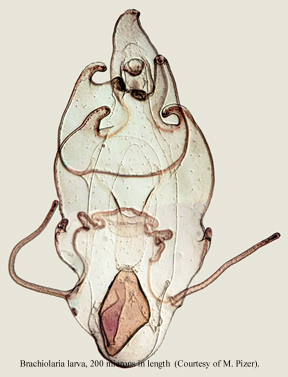
Asteroids
The echinoderms include the familiar sea stars, brittle
stars, and sea urchins, as well as the more enigmatic sea cucumbers and
crinoids. All species are marine, and most live in benthic habitats.
Many of the animals have a planktonic larval stage, some of which may live
in the plankton for months before settling as adults. Echinoid larvae
are among the smaller meroplankton,
approximately 0.01-0.03 mm in length, and are relatively rare to find in
the plankton. Consequently, we borrowed some specimens from other
researchers at FHL for these photographs.

Asteroids
Sea stars, or asteroids, develop through several larval
stages, including this brachiolaria larva of the ochre seastar,
Pisaster ochraceous. The larva uses its ciliated arms to sweep
food into its mouth as it glides through the water column. The arms
can also be used to supplement the larva's cilia-drive locomotion.
Each arm has a glandular tip, with which the larva attaches itself to the
substratum as it settles. The animal is then able to metamorphose
into the familiar five-armed adult form.
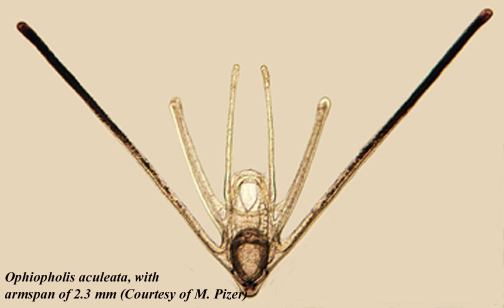
Ophiuroids
The brittle stars, or ophioroids, have a distinctive larval
form known as the ophiopluteus. Like all echinoderm larvae,
the ophiopluteus uses ciliated bands to feed on particles suspended in
the water column. Brittle star larvae may be found in the plankton
throughout the year in this region, and are thought to spend several weeks
in the plankton before settling as juveniles.
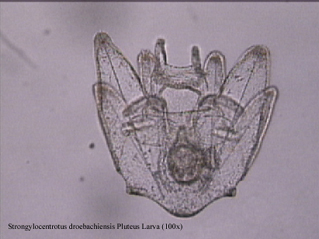 Echinoids
Echinoids
The echinopluteus larva (1 mm wide) of the green
sea urchin uses its extensive ciliated band for swimming and suspension
feeding. As the larva develops, it will add arms, changing from the
four-armed animal shown here to a six and then eight-armed individual.
The body form changes dramatically with metamorphosis. Many of the
larval structures used during planktonic life are lost, to be replaced
by appendages adapted to the adult's benthic lifestyle.
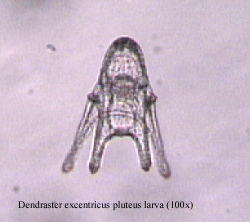 Young
sand dollars have a pluteus larva as well. This larva captures food
along a ciliated band that loops around the larval arms. Food is
then transfered by cilia to the mouth. The body shape slows the natural
tendency of the larva to sink, enabling it to stay in the food-rich upper
layers of the coastal ocean. Echinoids have separate sexes and reproduce
by free spawning gametes into open water.
Young
sand dollars have a pluteus larva as well. This larva captures food
along a ciliated band that loops around the larval arms. Food is
then transfered by cilia to the mouth. The body shape slows the natural
tendency of the larva to sink, enabling it to stay in the food-rich upper
layers of the coastal ocean. Echinoids have separate sexes and reproduce
by free spawning gametes into open water.
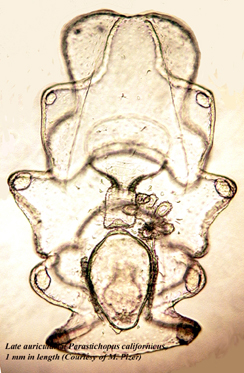
Holothurians
Sea cucumbers, such as this larva of Parastichopus
californicus, begin life as a feeding planktonic larvae in the early
summer. They swim in a gliding motion, using a ciliated band, similarly
to other echinoderm larva. The larvae feed in the plankton for one
to two months, after which they settle subtidally, in areas with high current
flow.